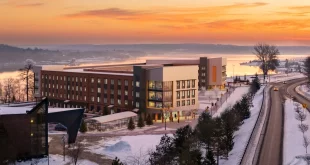This past week the Michigan DNR highlighted the end to the mystery of where deep-water lake trout spawns occur. The spawning site for deep-water lake trout, was discovered by a research team onboard the research vessel Lake Char last year. About 400 feet below the surface, just north of Isle Royale, the team found the deepest occurrence of lake trout spawning. Until now the spawning habits of the subspecies, deep-water lake trout was a mystery.
Great Lakes Fishery Commission (GLFC), academic, federal and state agency funded research team, began this project back in 2018. Deploying advanced acoustic telemetry and underwater drone technologies to track, locate, identify and verify were the fish spawns in off the north coast of Isle Royale. But first the teams needed to find a population of the subspecies. Based on information gathered in 2008, scientists returned to the Isle Royle site, where they captured spring and fall spawning Deep-water lake trout.
After tagging the fish and dropping their other tracking equipment in the water. The unattended receivers gathered information pinpointing the exact location of the fish’s spawning sites. Next and underwater remotely operated vehicle was dipped below the surface to seek evidence of spawning. More research at the site and of the samples taken will still need to be done. As researchers want to know how these subspecies survive and thrive in the cold temperatures. Lake trout are highly adaptive cold water fish, and have diversified, into numerous eco-types based on the variable of lake depth.
The Lake Superior lake trout are the last of the surviving species in the Great Lakes, as an invasion of a parasitic lamprey entered the lakes, and over fishing, led to much of the population to dwindle back in the 1940’s. Which spelled disaster for the Great lakes food web; Lake trout are incredibly important to the health and eco-system of the lakes, as the lakes’ top predator fish. After the population was decimated, natural resource agencies in the Great Lakes began efforts to restore the lake trout to the lower great lakes. While scientists and natural resource agencies worked on the restoration of the lake trout. Teams worked on the intervening with sticking non native salmon, in order to control invasive alewife. The agencies also began international efforts regulating commercial fishing ,managing sea lamprey and stocking hatchery fish. . In recent years those programs have begun to show the fruit of their labor, with discoveries of lake trout spawning naturally in Lake Huron and Lake Michigan. Lake Erie and Lake Ontario are further behind in that process.
 Keweenaw Report Your Source for Local News and Sports
Keweenaw Report Your Source for Local News and Sports




